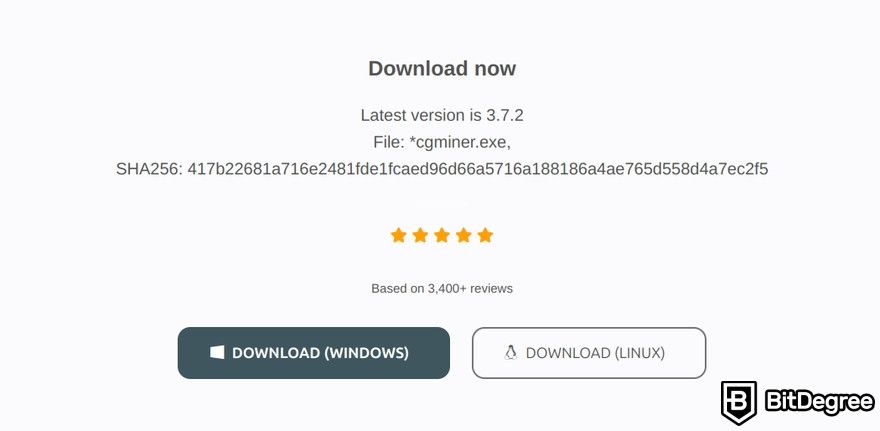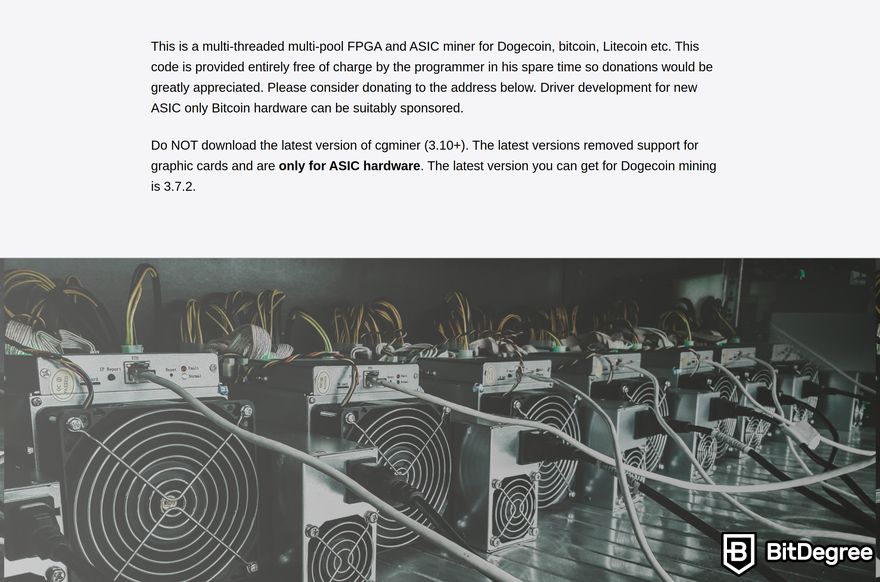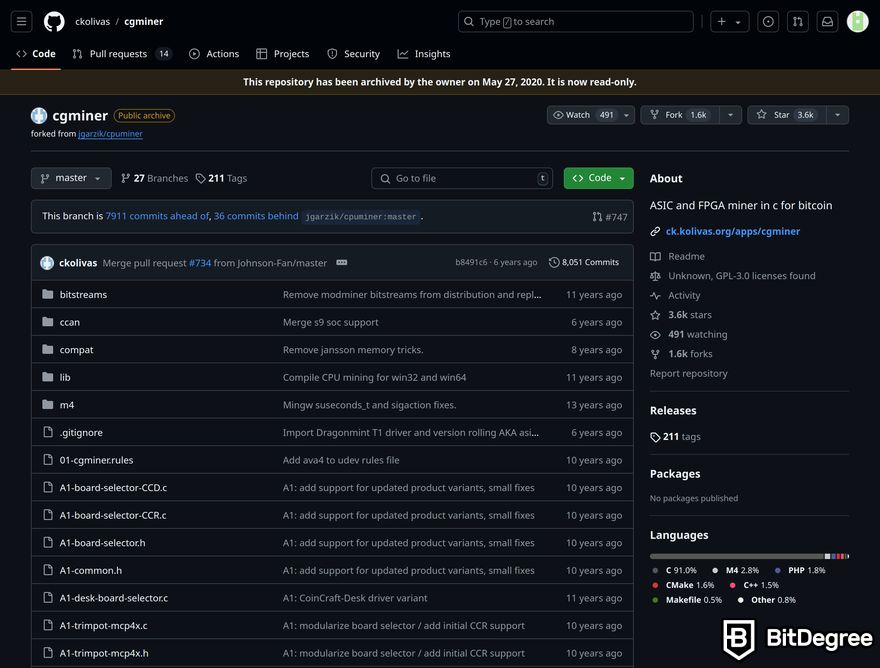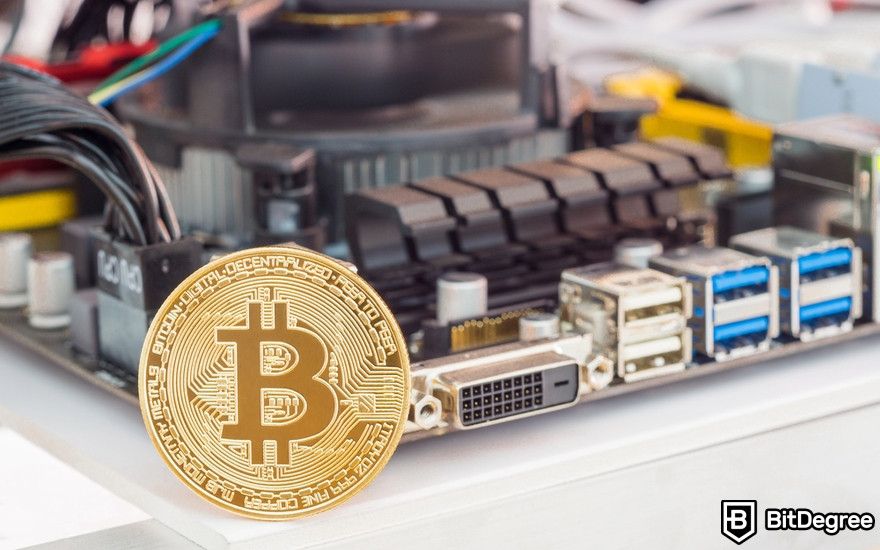
Stop overpaying - start transferring money with Ogvio. Sign up, invite friends & grab Rewards now! 🎁
With crypto mining becoming a lucrative yet competitive field, many miners seek software that can deliver flexibility and performance. If you’re exploring this space and looking for robust mining software, my CGMiner review might suit your needs.
This platform is a highly versatile and open-source mining application. Known for its robust features and cross-platform support, CGMiner has garnered attention for being adaptable to multiple rigs and cryptocurrencies.
When it comes to cryptocurrency mining, it’s also important to know the best practices to secure your assets. One of them is storing your coins in a hardware wallet like Ledger Nano X or Trezor Safe 5.
Verdict at a glance: CGMiner is a versatile and reliable mining software, particularly for experienced users. Its open-source nature allows for extensive customization, enabling people to optimize their mining setups. It supports multiple hardware types, including ASIC and FPGA miners. However, CGMiner isn’t beginner-friendly, as its command-line interface can be challenging for newcomers. Plus, the software is not being developed further, which may present concerns over future updates and security.
Pros
- Open-source software
- Cross-platform support
- Supports multiple hardware
- Allows for remote management
- Provides advanced mining features
Cons
- Not beginner friendly
- Inactive development
- No GPU mining support
Table of Contents
- 1. What is CGMiner?
- 2. CGMiner Review: PROS
- 2.1. Open-Source Software
- 2.2. Cross-Platform Support
- 2.3. Supports Multiple Hardware
- 2.4. Allows for Remote Management
- 2.5. Provides Advanced Mining Features
- 3. CGMiner Review: CONS
- 3.1. Not Beginner Friendly
- 3.2. Inactive Development
- 3.3. No GPU Mining Support
- 4. CGMiner Mining Fees
- 5. How to Use CGMiner?
- 5.1. How to Download and Set Up CGMiner?
- 6. Conclusions
What is CGMiner?
It’s only natural to begin my CGMiner review with an overview of the platform so you can get a clear understanding. This will help you make an informed decision about whether it fits your needs.
CGMiner is an open-source software designed for cryptocurrency mining, including Bitcoin (BTC), Litecoin (LTC), and Dogecoin (DOGE). Initially developed to work with AMD GPUs, it has since evolved to support a wide range of hardware, including ASICs and FPGAs, making it versatile for various mining setups.
So, how does CGMiner work? It operates as a command-line program, meaning it requires users to input commands into a command-line interface (CLI) to interact with the software. CGMiner connects to mining pools through protocols like Stratum, which helps optimize the mining process by distributing tasks among various miners.

Let's discuss Stratum in more detail. It's a protocol widely used in Bitcoin mining that facilitates efficient data exchange between miners and mining pools[1]. Stratum continuously provides updated tasks to miners, reducing latency and improving overall mining performance.
That said, CGMiner is great for experienced miners who are comfortable working with command-line interfaces and configuring their mining operations manually. Moreover, it can be a great option for those managing multiple mining rigs or looking to maximize their hardware's performance.
Additionally, based on several user CGMiner reviews, this mining tool has been widely adopted and trusted by miners since its inception. Its open-source nature ensures transparency, and the mining process is well-documented across various resources.
Overall, the platform is a robust and legitimate mining tool, as mentioned in this CGMiner review. It’s particularly suited for advanced users who want full control over their mining setup and hardware.
CGMiner Review: PROS
Now that we've covered the basics of what this application is and answered the question, "How does CGMiner work?", it's time to dive into the key advantages of this mining software.
Open-Source Software
One of CGMiner's standout features, and something I already highlighted in my CGMiner review, is that it’s an open-source program. But what does "open-source" mean, and why does it matter? Simply put, open-source software means it's publicly accessible, allowing anyone to view, modify, and distribute it.
This is different from closed-source software, where the source code is proprietary and controlled solely by the developers. With closed source, users are limited to the features and updates the creators choose to release, often resulting in slower development and limited flexibility.

Open-source software, like CGMiner, provides significant advantages. First, it fosters collaboration. Developers worldwide can contribute to its improvement, leading to quicker updates, bug fixes, and new features.
Second, open-source software's security is up-to-date. Since anyone can audit the code, vulnerabilities can be identified and addressed faster than in closed-source projects.
For cryptocurrency miners, using open-source software like CGMiner offers another benefit – customization. You can tweak CGMiner to suit your mining setup, adjusting everything from pool configurations to hardware settings. This flexibility is especially important in a field where mining technology constantly evolves, allowing miners to stay competitive.
In short, CGMiner's open-source nature is a key advantage, making it a highly flexible and reliable option for experienced miners.
Cross-Platform Support
One significant advantage highlighted in this CGMiner review is its cross-platform support. Compatible with both Windows and Linux, the application allows miners to choose the operating system that best suits their needs. This flexibility ensures users can run their mining setups regardless of their platform preference.
But why is cross-platform support important? It increases accessibility, allowing miners to use CGMiner on both dedicated mining rigs running Linux and personal computers with Windows. This adaptability simplifies the management of multiple devices and prevents miners from being confined to a single platform.

When comparing CGMiner’s Windows and Linux versions, both offer similar core functionalities, including mining pool support, hardware control, and monitoring features. However, the Linux version is generally considered more stable and efficient, especially for large-scale operations.
One of the reasons is that Linux is often better optimized for long-term, high-performance tasks and allows more control over system resources. Windows, on the other hand, may be easier for beginners due to its user-friendly environment, but some users report higher resource consumption compared to Linux.
In summary, the cross-platform support adds great value, making CGMiner versatile and accessible to a broad range of users. As highlighted in this CGMiner review, the ability to switch between Windows and Linux versions allows miners to optimize their setups based on their needs and preferences.
Supports Multiple Hardware
CGMiner supports multiple hardware types, including ASIC and FPGA miners, making it a versatile choice for users. For those unfamiliar with ASIC and FPGA miners, let's delve into what they are.
Firstly, let's discuss ASIC miners. ASIC, or Application-Specific Integrated Circuit, refers to hardware designed exclusively for mining cryptocurrencies like Bitcoin or Litecoin.
ASIC miners are very powerful because they’re optimized for the sole task of mining. They offer high hash rates and efficiency compared to general-purpose hardware like GPUs.

So, how does CGMiner work with ASIC miners? It fully supports a wide range of devices from manufacturers like Bitmain and Avalon, offering advanced control over hardware settings such as clock speed and voltage. This enables users to fine-tune performance to maximize profitability.
FPGA, or Field-Programmable Gate Array miners, are hardware devices that can be reprogrammed after manufacturing. While FPGAs aren’t as specialized as ASICs, they offer a balance between flexibility and efficiency, providing more customization options for users.
Now, how does CGMiner work with FPGA miners? It supports several FPGA platforms, such as Icarus and ModMiner, by including specific drivers and configurations. Furthermore, CGMiner manages the custom firmware or bitstreams required to operate FPGAs through its command-line interface.
Overall, CGMiner’s support for ASIC and FPGA miners is a significant advantage. So, whether you’re using ASICs for sheer power or FPGAs for versatility, CGMiner provides the tools needed to optimize and control your mining hardware for better results.
Allows for Remote Management
Another notable key advantage I want to mention in my CGMiner is that this software supports remote management. This feature enables users to control and monitor their mining operations from different locations, which is particularly useful for large-scale setups or those managing multiple devices.
So, how does CGMiner’s remote management work? It uses a JSON-RPC interface that lets users connect to their rigs remotely via web interfaces or command-line access. This allows them to tweak settings, monitor performance, and receive real-time updates without physical access to the equipment.
In addition, JSON-RPC is a lightweight, stateless remote procedure call (RPC) protocol that uses JSON (JavaScript Object Notation) to encode messages. In the context of crypto mining, it facilitates communication between mining software and remote clients, such as management tools or dashboards, enabling remote control.

For instance, miners can use JSON-RPC to retrieve real-time data like hash rate, temperature, or mining pool status and send commands to adjust mining parameters remotely. Due to its simplicity and compatibility with multiple programming languages, it’s widely used in mining software, including CGMiner.
Now, let’s talk about the benefits of remote management. First, it saves time and effort, particularly for miners managing large-scale operations or multiple rigs across different locations.
Furthermore, remote management allows for quick responses to issues like overheating or hardware malfunctions, which can significantly impact efficiency. It also enables users to optimize their rigs' performance without being physically present, increasing overall uptime and profitability.
Provides Advanced Mining Features
One of the key reasons CGMiner remains popular among miners is its advanced features, including dynamic clocking and voltage control, fan speed control, multiple mining pool support, and sophisticated monitoring tools. Let's explore them one by one.
Dynamic clocking and voltage control allow users to adjust the clock speeds and voltages of their hardware in real time. This helps fine-tune the system to achieve the ideal balance between performance and energy efficiency. Users can increase hash rates when needed or reduce energy consumption during less intensive periods.
Another useful feature is fan speed control. CGMiner allows users to set and adjust the speed of their cooling fans, which is crucial for preventing hardware from overheating during extended sessions. This ensures optimal temperatures are maintained, prolonging the life of the equipment.

Multiple mining pool support is also CGMiner's notable feature that enables miners to connect to several pools simultaneously. By the way, mining pools are groups of miners who combine their computational resources to solve complex algorithms and share rewards based on their contributions.[2].
This helps to distribute mining tasks and minimize downtime. CGMiner automatically switches between pools if one goes offline or underperforms, ensuring consistent mining performance without interruption.
Additionally, CGMiner offers advanced monitoring tools that provide real-time data on hash rates, temperatures, hardware performance, and pool statistics. These features enable users to closely observe their rigs, making it easier to spot potential issues and optimize performance on the go.
Overall, CGMiner's advanced features make it a highly customizable and powerful tool for experienced users. Whether you're optimizing performance through dynamic clocking or monitoring hardware health in real time, it provides the control needed to maximize operations effectively.

Did you know?
All Crypto Exchanges may look similar to you but they're NOT all the same!
CGMiner Review: CONS
Every tool, including CGMiner, has downsides, and in this CGMiner review, let’s highlight some of the challenges users might face. Whether related to user experience or setup complexity, understanding these cons can help you decide if it's the right fit for your mining needs.
Not Beginner Friendly
One of the main drawbacks I should mention in my CGMiner review is that the software isn’t beginner-friendly. While it's packed with advanced capabilities, these can be overwhelming for newcomers to cryptocurrency mining.
The command-line interface presents a particular challenge for users unfamiliar with such environments. This contrasts with the more intuitive graphical interfaces offered by other mining tools, which cater better to beginners.

The steep learning curve is another hurdle. From installation to configuration, every step requires technical knowledge, especially in navigating the CLI and manually setting up mining pools, hardware parameters, and monitoring tools. For someone new to mining, understanding how to properly optimize settings using a CLI can be daunting.
Additionally, the absence of a graphical user interface (GUI) makes things more difficult for beginners. Many prefer a visual, user-friendly interface that simplifies tasks like managing pools and monitoring hardware. Relying solely on text commands and outputs can make troubleshooting more complicated for those unfamiliar with command-line tools.
In short, while CGMiner is a powerful mining tool, it’s not particularly well-suited for beginners due to its complex CLI and lack of user-friendly features.
Inactive Development
Another notable drawback I want to mention in my CGMiner review is that the software is considered inactive in terms of development. Its official GitHub repository was archived in May 2020, meaning no new updates or official support have been released since then.
This can pose several challenges for miners looking for up-to-date mining software. Without active development, CGMiner may struggle to stay compatible with new mining hardware or algorithm changes, leaving users potentially at a disadvantage.

Inactive open-source projects also introduce potential security risks. Outdated software becomes more susceptible to vulnerabilities and exploits, which is particularly concerning in the cryptocurrency industry. Additionally, miners may miss out on new features and optimizations, limiting their ability to improve efficiency and profitability.
Despite these drawbacks, CGMiner remains functional for many mining operations, and the community still offers support and forks for the project. However, the lack of official updates can make troubleshooting more difficult, especially when dealing with newer hardware or software configurations.
Overall, as highlighted in this CGMiner review, the inactive development status of CGMiner presents a clear limitation. While it’s still a powerful tool, miners should weigh the risks and consider alternative options if they need active support and regular updates to stay competitive.
No GPU Mining Support
Another point to consider in this CGMiner review is that the software no longer supports GPU mining in its latest version. This change was introduced in 2013 when it shifted exclusively to ASIC and FPGA hardware.
The decision to drop GPU support was due to the rapid advancements in ASIC technology, which had become far more efficient for Bitcoin mining than GPUs. As ASICs began to dominate the market, GPU mining became less viable for Bitcoin, leading CGMiner to phase out its support for GPUs

The lack of GPU mining support means that users looking to mine altcoins, which can still be mined effectively with GPUs, have to look for alternative software. This limitation can impact CGMiner's flexibility, as it no longer caters to miners who prefer or require GPU-based solutions.
While this shift was necessary to keep CGMiner optimized for ASIC miners, it restricts its user base to those who have the specific hardware required. The absence of GPU support might make CGMiner less appealing to users who prefer to use GPU-mining hardware.
In short, the lack of GPU mining support can be a drawback for users looking for flexibility in hardware. However, for those focusing on ASIC-based mining, CGMiner remains a reliable and powerful tool.
CGMiner Mining Fees
Now, let's proceed with this CGMiner review by taking a look at the mining fees associated with the platform.
As an open-source mining tool, CGMiner itself does not charge users any direct fees for using the software. However, miners must be aware of fees imposed by mining pools and any other related costs.
When using CGMiner to connect to mining pools, the pools themselves often charge a percentage of the mining rewards. These fees can vary depending on the pool.
For example, mining pools typically charge between 1% to 3% of the rewards earned. Some pools might not charge miners, but this is less common and might come with other limitations like reduced payouts or less frequent payments.

In addition to pool fees, transaction fees are another factor to consider. When a mining pool successfully mines a block, the transaction fees associated with the block are often distributed to the pool members. However, some pools might take a percentage of these fees before distributing them to miners.
Other potential costs miners should keep in mind include hardware and electricity costs. While these aren’t directly related to CGMiner itself, they’re an integral part of the overall mining process. For example, electricity consumption can greatly affect profitability, especially when running ASIC devices, which tend to use significant amounts of power.
Overall, CGMiner doesn’t impose any fees, but miners should carefully choose mining pools that align with their goals and understand the pool's fee structure. This will help optimize profitability while using CGMiner as a mining tool.
How to Use CGMiner?
In this CGMiner review chapter, let’s go over the steps for setting up and using this mining software. While CGMiner is a powerful tool, it does require some technical know-how to get up and running effectively.
How to Download and Set Up CGMiner?
Remember that CGMiner is cross-platform, meaning you can use it on Windows and Linux. So, let’s walk through the steps to install CGMiner on these operating systems.
Setting Up CGMiner on Windows
Installing CGMiner on Windows is relatively easy. Here are the steps on how to use CGminer on Windows:
Step 1: Go to the official CGMiner GitHub repository and download the [.zip] file. Make sure you download the version that’s compatible with your hardware.
Step 2: Navigate to the download folder via your file manager. Extract the [.zip] file to a desired location on your computer.
Step 3: Install the software’s dependencies, including Microsoft Visual C++ Redistributable and Python.
Step 4: Open the extracted CGMiner folder and locate the [.bat] file. Next, open the file in a text editor. Here’s an example of how the [.bat] file looks like:
setx GPU_FORCE_64BIT_PTR 0
setx GPU_MAX_HEAP_SIZE 100
setx GPU_USE_SYNC_OBJECTS 1
setx GPU_MAX_ALLOC_PERCENT 100
setx GPU_SINGLE_ALLOC_PERCENT 100
cgminer --scrypt -I 10 -o stratum+tcp://pool.[address:port] -u [wallet address].[password] -p [password]
pause
Ensure to replace [address:port] with your mining pool address, [wallet address] with your actual wallet address, and [password] with your password. If you don’t have a crypto wallet, you get one from several popular exchanges like Binance.
Step 6: Disable your antivirus if needed. Some antivirus programs might flag CGMiner as a threat.
Step 7: Run CGMiner by double-clicking the [.bat] file. The program will start, and you should see CGMiner begin mining if everything is set up correctly.
That’s it! You’ve successfully set up CGMiner on Windows. If you encounter issues, check for driver updates and review the CGMiner documentation to help with the troubleshooting.
Setting Up CGMiner on Linux
Now, let’s go over how to use CGMiner on Linux. Follow the steps below:
Step 1: Open your terminal and update your system by running the following command:
sudo apt update && sudo apt upgrade
Step 2: Install the required dependencies. Run the command:
sudo apt install build-essential autoconf libtool pkg-config libcurl4-openssl-dev
Step 3: Go to the official CGMiner GitHub repository and download the latest CGMiner’s latest version. You can run the following command on the terminal:
git clone https://github.com/ckolivas/cgminer.git
Step 4: Navigate to the downloaded folder using the cd command and compile CGMiner. For example:
cd cgminer
./autogen.sh
./configure
make
Step 5: start CGMiner with the following command: ./cgminer -o [pool_url] -u [username] -p [password]. Make sure to replace [pool_url], [username], and [password] with your actual mining pool information.
Congratulations! You now have CGMiner set up on your Linux operating system. If you want to further configure CGMiner or learn how to use CGMiner's advanced features, check the official documentation or ask on its forums.
Conclusions
Wrapping up my CGMiner review, this mining software is a solid choice for experienced cryptocurrency miners looking for flexibility and control. CGMiner’s open-source nature is a plus, allowing you to tweak the software to fit your specific needs. If you're someone who likes to optimize and fine-tune your setup, you'll appreciate CGMiner's ability to support a variety of hardware, including ASIC and FPGA miners.
Another standout feature, as mentioned in this CGMiner review, is its cross-platform support. Whether you're running Linux or Windows, CGMiner has you covered. This flexibility means you can use the operating system that works best for you. Plus, its remote management capabilities make it even easier to handle multiple rigs from different locations.
That said, CGMiner isn't exactly beginner-friendly. The command-line interface can feel intimidating if you're new to mining. Plus, the lack of recent updates could be a concern for some, especially when it comes to keeping up with newer mining hardware and security updates.
But overall, if you're an advanced miner looking for a customizable and reliable tool, CGMiner remains a great option. Remember that you need a wallet to use CGMiner, thus you can register one on crypto exchanges like Binance.
The content published on this website is not aimed to give any kind of financial, investment, trading, or any other form of advice. BitDegree.org does not endorse or suggest you to buy, sell or hold any kind of cryptocurrency. Before making financial investment decisions, do consult your financial advisor.
Scientific References
1. R. Recabarren, B. Carbunar: 'Hardening Stratum, the Bitcoin Pool Mining Protocol';
2. X. Liu, W. Wang, D. Niyato, et al: 'Evolutionary Game for Mining Pool Selection in Blockchain Networks'.


